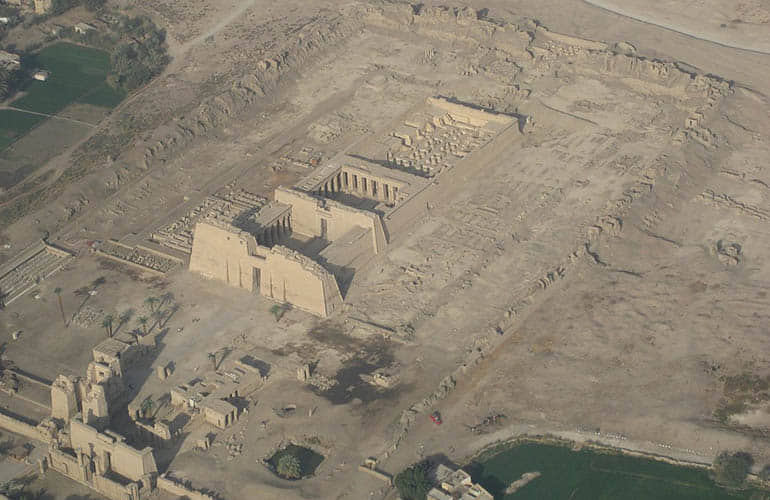A Brief History of Medinet Habu
Although second only to Karnak in size and detail, the beautiful temple of Medinat Habu is one of the less-visited sights in Thebes. The complex is dominated by the huge mortuary temple of Ramses III, modeled on Ramses IPs mortuary temple at the Ramesseum.
Medinet Habu is the modern name of the area where Ramses III built his burial temple. Ramses III ruled Egypt for 31 years (approximately 1183-1153 B.C.). Medinet means “city” and Habu is actually the name of the city. Therefore it is “Habu City.” A straight axis runs through the temple, but originally there were several doors. The whole temple would have had a roof in ancient times.

Medinet habu temple
The temple is located on a hill, south of the temples of Vizier Ay and Horemheb. This place considered one of the original mounds where the creation took place (it was said that the members of the Ogdoad were buried there) had already been chosen previously by Hatshepsut and Thutmosis III to build a small enclosure for the worship of the god Amun, in two of its primary forms,
The Temple of Rameses III
The temple occupies an area of about 7,000 m2 and was designed by the architect Amenmose, starting its construction from the fifth year of the reign of Rameses III. We are in front of a fortified temple of considerable proportions that also contains an annexed palace that served as a temporary residence for the pharaoh. The structure is similar to that of the neighboring temple of Rameses II, the Rameses, whom Rameses III greatly admired, to the point of having dedicated a chapel of worship in his temple, near the treasure rooms and the hypostyle room. The Sanctuary is made up of several enclosures enclosed in walls until reaching the sanctuary of Amon.
Visiting the Mortuary Temple Of Ramesses III
During later invasions of Egypt in the 20th Dynasty, the entire population of Thebes took refuge within the temple’s massive enclosure walls.
Ramses Ill’s many military campaigns are recorded in detail on the temple’s pylons and walls. In the second court, colorful reliefs depicting religious festivals are well preserved, partly thanks to the early Christians who converted the area into a church and covered the offending images with plaster.
To the west of the first court are the remains of Ramses’s royal palace. Also within the enclosure walls is the smaller Temple of Amun, originally built by Hatshepsut but altered by Tuthmosis III and enlarged and modified up to Roman times. [ Don’t miss our Luxor day tours ]
Explore the World’s Largest Open-Air Museum
Located at the entrance of the temple, on the first pylon, and of numerous scenes represented in the building in which battles, parades, ceremonies, and rituals are visually displayed. Among the images, some are tremendously dramatic: chariots in full attack, armies on the march armed to the teeth, naval confrontations, prisoners marked with the name of the pharaoh or scribes meticulously counting mountains of hands and cut off penises to the enemy to count their losses.
Ramesses III
Ramesses III (reigned from 1195 BC to 1164 BC) is the second pharaoh of the 20th dynasty of the New Egyptian Empire. His father Setnakhte, a general of no royal descent, founded the new dynastic line after the death of Queen Twosret and reigned four years during which he brought his son to power. The third Ramesses III, who was on the throne a whopping 31 years and 49 days, had two principal queens, Isis Ta Hemdjeret and the one has known only as Queen X, who gave him ten male children, three of whom resigned after his father. Among the most famous events of her reign are several invasions of enemy peoples of Egypt, a strike of the workers of Deir el-Medina (the builders of the tombs of the Theban necropolis) and royal massacre
On the same day of his coronation at Karnak, Ramses III ordered the construction of his funerary temple at Medinet Habu.
Ramesses III waged three defensive campaigns, two against the Libyans and one against the so-called People of the Sea [ read more about Battle of the delta 1175 BC ]
. Of these three victorious wars, many episodes appear in Medinet Habu. “Some of the battles we see are real and others are not,” says Salvador Costa, who recalls that the wars waged by Ramses III, although he tries to present them with the glory of the imperial expansion campaigns of Seti I or Ramesses II, were purely defensive.
Although a lot of historical information can be extracted from Medinet Habu’s scenes about the way the war was waged at the time and about Egypt’s enemies, the intention of these representations and others, was to show the pharaoh as the guarantor of the cosmic order (Maat), defeating the chaos and the dangers that threatened the country.
It’s one of the best-preserved temples where you can still see the Egyptian art with magnificent conservation of the color of their paintings.





